
8 minute read
Wild Foods on the Florida Trail
by Anthony Tridente, GIS Program Manager
Forest ponds and wetlands along the trail are worth a look for fish and waterfowl.
Advertisement
The Florida Trail (FT) guides users through some of Florida’s most pristine and well-conserved public lands. The trail providers hikers with a clear path to experiencing Florida’s seasonal spectacles such as blooming wildflowers, or bird and butterfly migrations. With everything the trail already offers I wouldn’t expect many folks to wonder, what else is there? However, the answer is quite a bit more. For intrepid folks and those who are interested in wild foods, the trail is there to get you fishing, foraging, and hunting on some of the best ground in Florida! How many long-distance hikers have had a fresh fish dinner while conquering the Florida Trail? Hard to say but with all the time spent walking along and trudging through Florida waters, this is more of a possibility than you might think. While ephemeral wetlands and stagnant swampy waters aren’t going to hold many fish – the trail crosses or parallels many creeks and rivers that will. Even if you inevitably need to venture off-trail by a little bit, the FT can lead you to the fillets. I’ve had some great success finding fish in small springs and forest ponds that lie just off the trail. You might not catch a personal best largemouth bass, but you may very well find a puddle full of hungry, eating-sized fish that see virtually zero pressure from fisherman and are ready to check out whatever you are presenting. A day-hiker could pack out all the tackle they care to carry, and a thru-hiker could improvise a successful small-water outing with the simplest implements; a couple hooks, weights or bobbers, and some line packed neatly in a small nook of your bag somewhere. When I go backpacking where there is an opportunity for fishing, I always have a Cuban yo-yo clipped to the outside of my bag with a bit of necessary tackle in a tiny plastic case. In addition to fish, Florida’s landscapes offer a diverse array of forage to keep you scouring for treats all year long. With a long growing season and plenty of moisture, I can’t imagine a better place to go looking for wild fruits. Florida is known far and wide for its citrus, and you can find some out there in the woods. The wild sour oranges you are most likely to find won’t be sweet like the ones you buy in the grocery store, but if I ever happen

Photo courtesy of Anthony Tridente
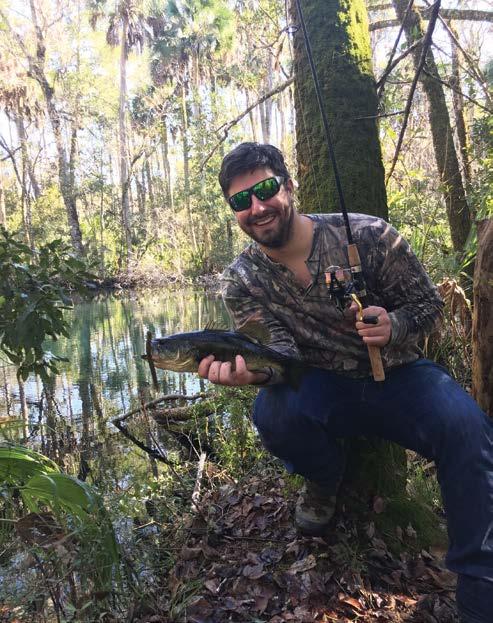
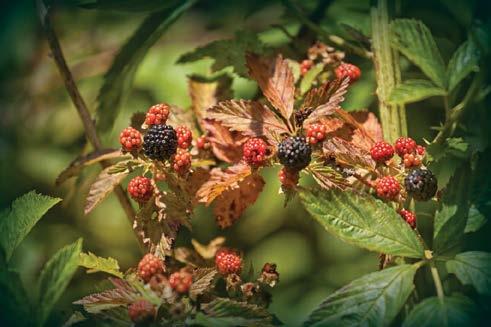
upon a few I’ll be bringing them home to try my hand at making sour orange pie. For those that don’t mind hiking in the hottest months, berries abound! Blueberries, blackberries, huckleberries, persimmons (yes, technically a berry!), and more are out there for the picking. Berries grow in a wide variety of habitats across Florida. While not as common as berries, there are also varieties of wild apple and pear to be found, too. My personal favorite to forage are golden chanterelle mushrooms. They are absolutely delicious and a relatively easy-to-learn fungi for beginners. Besides being enjoyable to eat, I find them just as delightful to hunt. I love the way their apricot-orange color glows on the ground in lowlight conditions and I love spending time in the mature hardwood forests they tend to grow in near where I live. Mushroom foraging quickly became my new favorite hobby during the quarantine age and it’s really thrilling to learn new species and experiment with new places to look. Mushrooms alone could keep your calendar full as different species fruit at different times of year. I have found that a few days after a real hard rain can be the best time to go looking for them. Be sure to note where you find them, as good areas will usually produce year after year. Foraging can feel like an intimidating pursuit with a lot to learn, but the payoff is worth it. It takes a significant investment of time to learn to forage successfully and most importantly, safely! Until you are supremely confident with a given species, you should have a mentor or local expert check your harvest before you consume it to avoid accidental poisoning. Many local outdoor or naturalist clubs organize around foraging or at least lead field trips on the topic with local subject-matter experts. All this research can seem daunting, but the knowledge acquired will serve you well beyond looking for edibles. I find that the more I learn about the natural world through hunting, fishing, and foraging; I enjoy hiking, paddling, spending time at the beach, or other outdoor activities more because I have a better understanding of the sights and sounds around me. It shouldn’t be any surprise by now that the FT traverses some of the premier public hunting locations in Florida. While this might not be an activity for a thru-hiker with a full pack, the FT is a fantastic resource for hunters. The FT is a travel corridor for wildlife and people. The cleared tread offers a path of least resistance for game to travel as well as a quiet, navigable path for moving through Wildlife Management Areas (WMAs). I always want to know if the FT is close
Photo courtesy of Anne Davis
Photo courtesy of Anthony Tridente Wild Blackberries
A Bass sight-casted from the edge of a blue spring off the Florida Trail
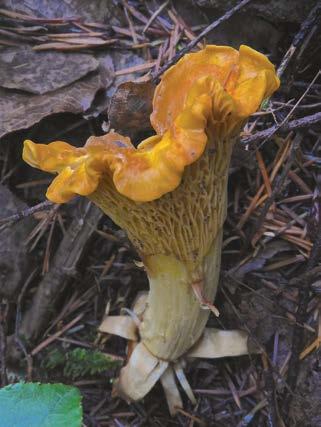
Golden Chantrelles

Photo courtesy of Glenn Kraeck to where I’m hunting. A great example of this is spring turkey season, where the trail has served me well in the past. The forest floor is usually crunchy unless wet, and forest roads offer sharp-eyed birds long sight lines to spot me well before I know they are there. If the trail is available, it may be your best bet to close the distance on that far-off gobbler. Also, the same out-of-way creeks, forest ponds and springs that you might score a nice fish out of, will host ducks and other harvestable waterfowl in the fall and winter. For deer and hogs, the trail may make the most sense for slipping into remote areas of a forest where hunting pressure is lighter. I’ve heard it said many times that most hunters apply their trade within an hour, or a mile, of where their vehicle is parked. Using the trail to get into areas that are miles from any road may be your key to greater success this upcoming season. There truly are infinite possibilities for enjoyment along the FT. Hopefully the information in this article has piqued your curiosity or helped you imagine new ways to enjoy your favorite section of trail. Before you head out in search of nature’s bounties, please do your homework, and understand the rules of regulations surrounding your intended pursuits. When hunting or fishing off the FT, it is imperative to make sure your planned activities are in-season for where and when you plan to go. Ensure you have purchased the appropriate licenses beforehand. To familiarize yourself with Florida’s hunting and fishing regulations, visit MyFWC.com. As a safety reminder, it is important to note that even during hunting season these public lands are shared-use
facilities, so you must be mindful that people are still welcome to walk the trails and engage in other forms of permitted recreation. In the case of foraging the rules are a little less clear, but most likely you will need a special use permit to forage on public lands. For USDA Forest Service lands, you would apply for one from the District Ranger’s office supervising the location you plan to harvest from. For WMAs, you would apply for one through FWC. If in doubt, you can always check with the local land manager for guidance about permissibility. It may take some figuring-out, but that’s all part of the fun. The satisfaction that comes from a belly full of wild food is a distinct joy and I hope you get to experience it for yourself if you haven’t already.
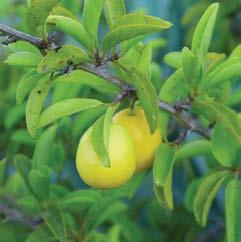
Photo courtesy of Scott Zona
Wild Hog Plum
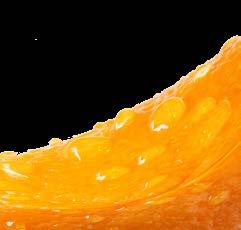
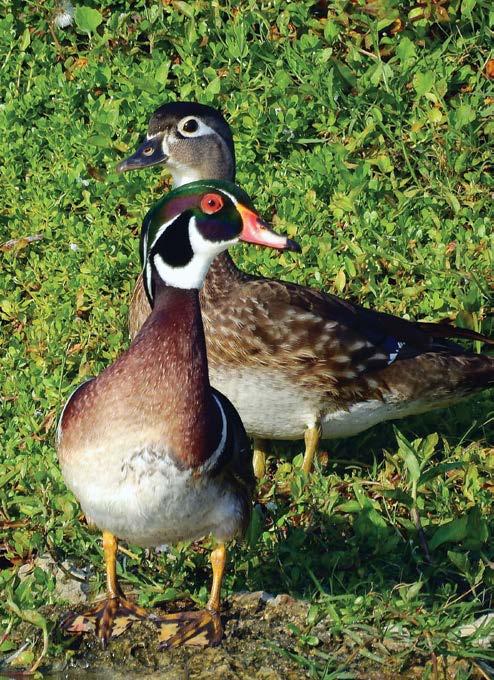
Wood Duck Pair
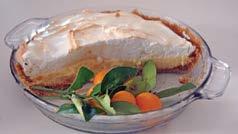
Sour Orange Pie Recipe
Recommended by Heartland Chapter Volunteer Melissa Bruneau Courtesy of authenticflorida.com
Ingredients
1 Graham cracker crust 4 Egg yolks 2 Teaspoons of sour orange zest - be sure to zest before you squeeze the juice! 1 (14-oz.) Can sweetened condensed milk 2/3 Cup of freshly squeezed sour orange juice
Meringue Topping: 3 Egg whites ¼ Teaspoon, cream of tartar ¼ Cup of sugar
Bake the crust according to package instructions. Set aside on a wire rack. Preheat the oven to 350 degrees F. Meanwhile, in an electric mixer with the wire whisk attachment, beat the egg yolks and sour orange zest at high speed until very fluffy, about 5 minutes. Gradually add the condensed milk and continue to beat until thick, 3 or 4 minutes longer. Lower the mixer speed and slowly add the sour orange juice, mixing just until combined, no longer. Pour the mixture into the crust. Bake for 10 minutes, or until the filling has just set. Cool on a wire rack, then refrigerate. Freeze for 15-20 minutes before serving. With a mixer, beat egg whites with cream of tartar until soft peaks form. Gradually beat in the sugar until stiff. Spread over filling; seal to edge of crust. Bake for 12-15 minutes or until meringue is golden brown.








